The Art Detective
Jeff Koons’s Art Is on the Moon, but His Prices Have Cratered. Can Power Players Reignite His Market?
Major shows will soon hit Hong Kong, New York, and London. Will a collector pay more than $50 million for his sculpture of Michael Jackson and Bubbles?
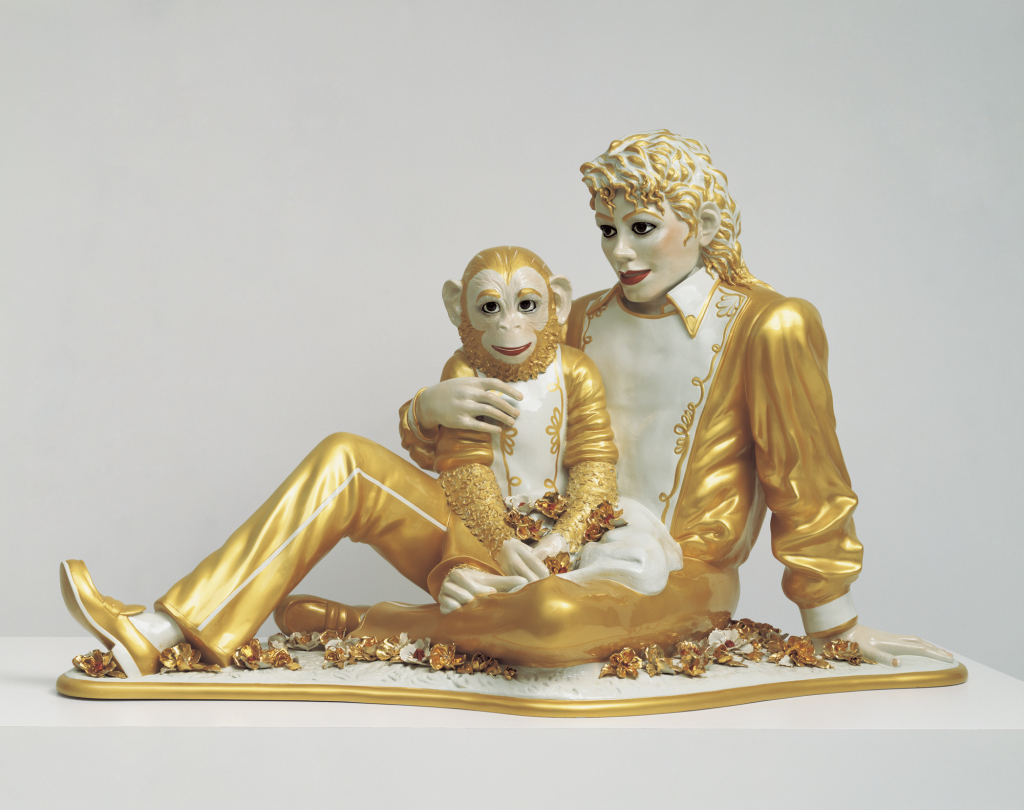
Underestimate Jeff Koons at your own peril.
The artist’s soaring ambition shows no sign of abating, market doldrums be damned. In the past year alone, Koons has taken on the moon, where his sculptures just landed after a weeklong journey—and the sun (more on that later).
Here on Earth, some of the 69-year-old artist’s biggest champions are working hard to reverse the recent downward trajectory in his prices.
The stakes are high. Koons’s auction totals have plummeted since his gleaming steel Rabbit (1986) fetched $91 million in 2019, making him the most expensive living artist in the world, the crown he still holds. Last year was particularly bad: Sales fell to just $27.8 million, down 84 percent from the peak of $170.8 million in 2014, according to the Artnet Price Database. Almost 40 percent of the 292 Koons lots offered failed to find buyers. He ranked 72nd on a list of artists’ annual auction revenue, down from 55th in 2022—itself a demotion from 2019, when he was 15th, according to Artnet data.
Such ebb-and-flow is not new for Koons. At various points in his long career, he has been the world’s most famous artist and the comeback kid. Right now he appears to be both at the same time. And so this spring, several powerful secondary market players are mounting Koons exhibitions in New York, London, and Hong Kong to remind everyone of his greatness.
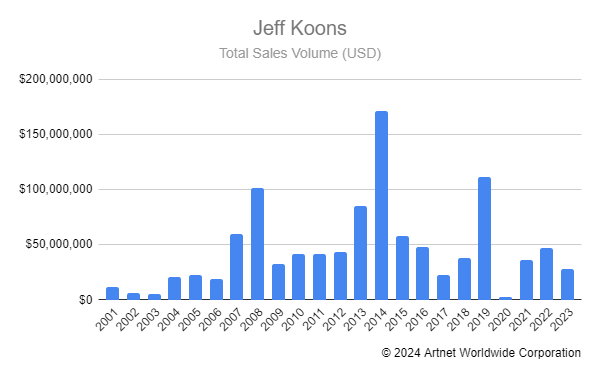
© 2024 Artnet Worldwide Corporation
They believe that his market will bounce back, realigning itself once again with his art historical significance.
“There’s no question about it,” said Dakis Joannou, who’s been collecting Koons for almost 40 years, becoming a close friend along the way.
Several significant works that the Greek collector originally acquired are now heading to Hong Kong for “Jeff Koons: 1979–1999” at Art Intelligence Global (AIG), the advisory firm co-founded by Amy Cappellazzo and Yuki Terase. The exhibition unites a dozen pieces from Koons’s early series, including the “Inflatables,” “Equilibrium,” and “Made in Heaven.” Most will be appearing in Asia for the first time, according to AIG. One work, Michael Jackson and Bubbles (1988), has an asking price in excess of $50 million. The exhibition will open on March 23 alongside Art Basel Hong Kong.
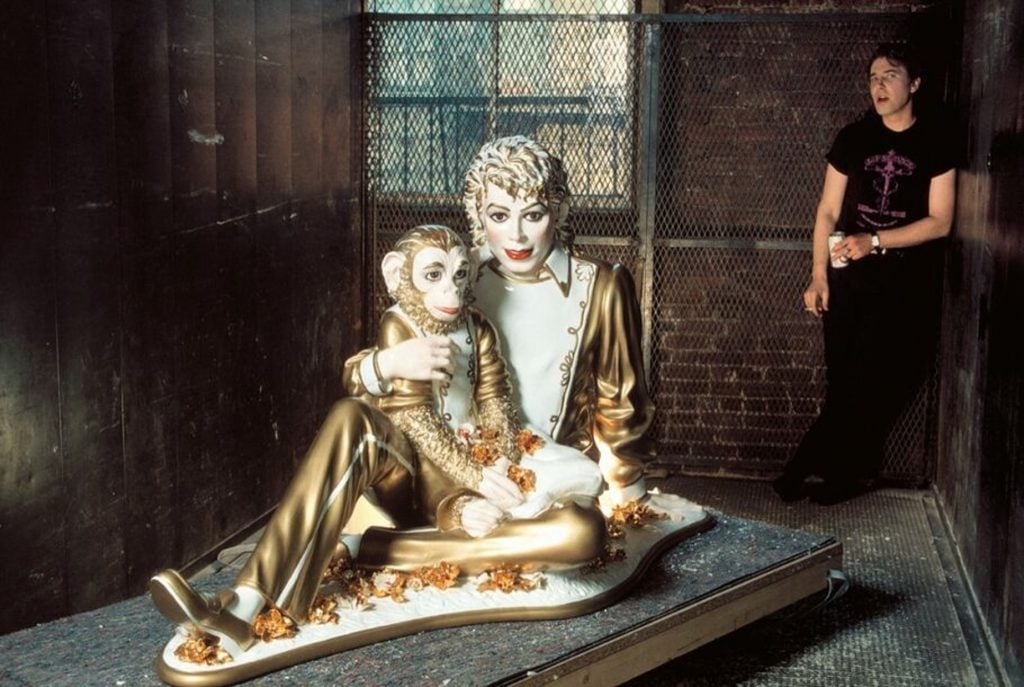
Jeff Koons with his porcelain sculpture of Michael Jackson in a SoHo freight elevator, 1989 ©️ Thomas Hoepker/Magnum Photos
“Jeff Koons is one of the most well-known names in Asia, and yet he’s never really had a proper survey there, especially of the early works,” Terase said in an interview. “We are doing something very meaningful because a lot of people have only seen the works on social media and the internet, but never in person.”
In London, Skarstedt gallery will display five mural-size canvases in “Jeff Koons: Paintings, 2001–2013.” Opening March 1, the show will arrive in time for the marquee London auctions of Impressionist, modern, and contemporary art. It will include works from the “Easyfun-Ethereal” series, which started with seven paintings commissioned by the Deutsche Guggenheim Berlin in 2000. (None of the Guggenheim’s paintings are in the show, the gallery confirmed. But two other pieces from the series are included, having recently come to auction, with Hot Dog, 2002, fetching $1.9 million in November and Pancakes, 2001, selling for $867,000 in 2021.)
Then, New York’s Mnuchin Gallery will revisit its watershed 2004 exhibition, “Jeff Koons: Highlights of 25 Years,” which included many of his greatest hits, including Michael Jackson and Bubbles. The show began a new chapter for the artist, following a painful decade marked by the end of his first marriage in a bitter divorce and his near-bankruptcy while creating the “Celebration” series.
“It was an awe-inspiring show,” said Michael McGinnis, a partner at Mnuchin, remembering its impact when he was the head of contemporary art at Phillips.
Stellar reviews followed and Koons’s auction market took off, crossing $20 million in auction sales for the first time that year. It would not sink below that level until the global pandemic hit in 2020, when annual sales plummeted to just $2.7 million.
Mnuchin’s show, set for late April, will present 25 artworks spanning the artist’s entire five-decade career. “It will be a wow, wow, wow kind of show,” McGinnis said, declining to elaborate on the specific works because loans have not been finalized.
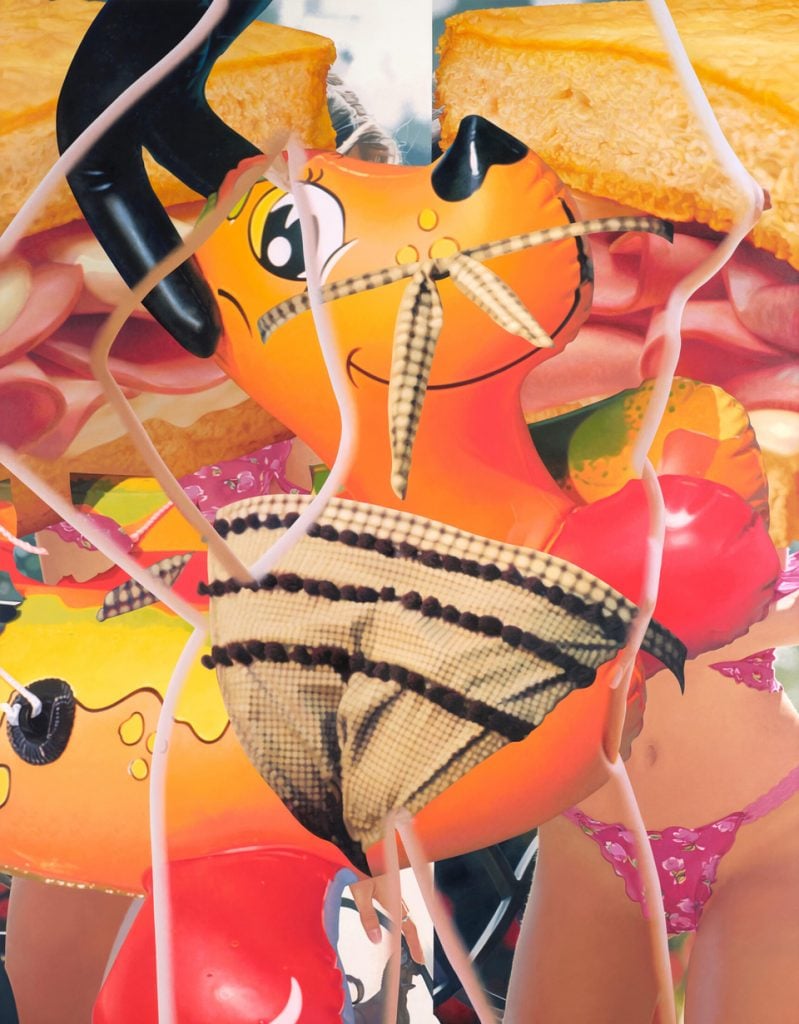
Jeff Koons, Hot Dog, 2002. © Jeff Koons Courtesy of Skarstedt
Those in the know whispered that hedge-fund billionaire and Mets owner Steve Cohen may loan his yellow Balloon Dog (1994–2000), instead of the orange sibling that was in the original show, courtesy of its then owner, Peter Brant. (Yes, it does fit!) Sadly, the Rabbit, which was in the 2004 show, is unlikely to make an appearance. (Museums hold three of the four pieces in the edition; the only one in private hands was reportedly bought by Cohen in 2019 and subsequently resold to billionaire financier Ken Griffin, market insiders told me.)
Back in Hong Kong, AIG’s lineup will include works that have become icons after appearing in prestigious exhibitions, such as the artist’s 2014 retrospective at the Whitney Museum of American Art. (Large Vase of Flowers, 1991, a massive, intricately carved wood bouquet, graced the cover of the Whitney’s exhibition catalog.) Terase and Cappellazzo are preparing for crowds, given the value of the artworks and their consequent insurance requirements.
“There will be a line around the block to see the show,” Cappellazzo said.
Several pieces have been closely linked to Joannou’s massive art collection, and they return to the market after decades. Take One Ball Total Equilibrium Tank (Spalding Dr. JK 241 Series), a seminal 1985 work comprising a basketball suspended in a tank. Joannou saw it at Koons’s first solo exhibition at the International With Monument Gallery in New York’s East Village. It made a memorable first impression, he said, “something I couldn’t get out of my mind.” He bought the work for $2,700.
“And that’s how eventually I got to meet Jeff and the whole thing started from there,” Joannou told me.
Joannou went on to acquire examples from almost every subsequent series Koons made (until the two most recent ones). He waited six years to get the red Balloon Dog, the first puppy from the “Celebration” series (and only after paying for its production). Twenty years would go by before he received a giant pile of Play-Doh (1994–2014).
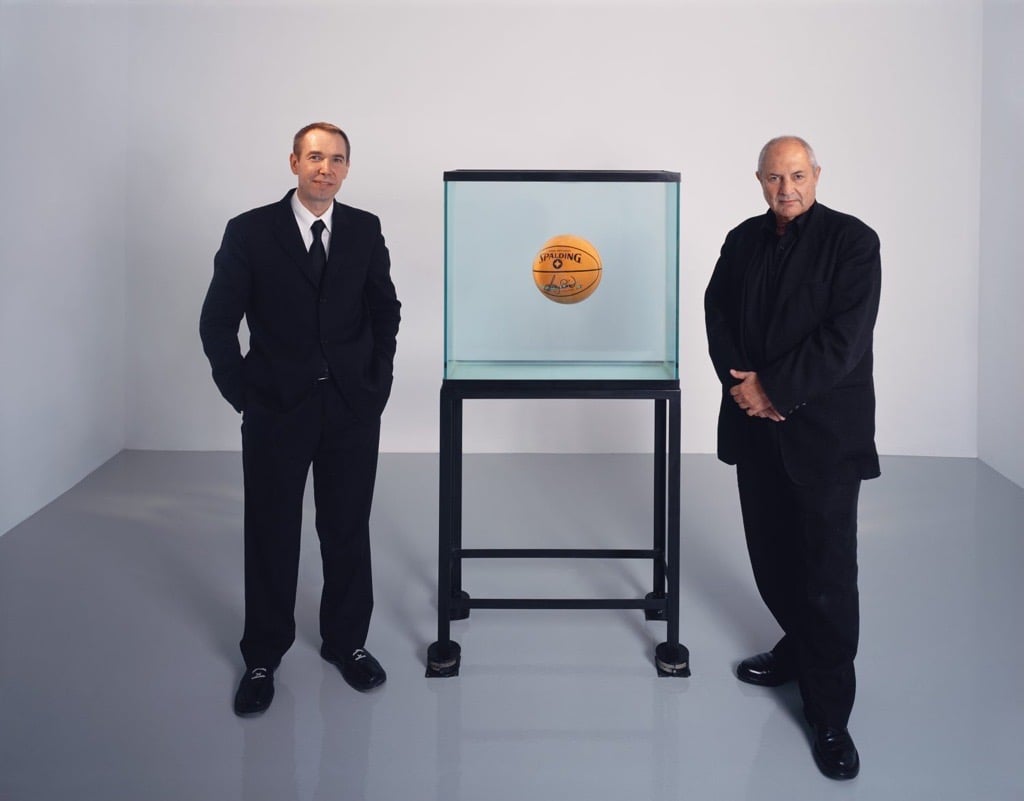
Jeff Koons & Dakis Joannou, 2004, by Todd Eberle © Todd Eberle
Courtesy: DESTE Foundation for Contemporary Art
The artist and his patron became close over the years. Joannou is the godfather of Koons’s son Ludwig. The artist created the famously unorthodox (camouflage-inspired) look of his collector’s yacht, Guilty, and designed a heart-shaped wedding cake for his daughter’s wedding. (That concoction featured 2½-foot-tall figures of a swan and a rabbit that would later become 12- and 14-foot-tall sculptures.) The two men’s families vacationed together on Greek islands. In 2010, Joannou invited Koons to curate a controversial show of his collection at the New Museum.
But the most poignant manifestation of their friendship appeared two years ago on the island of Hydra in Greece, where each summer Joannou’s Deste Foundation taps contemporary artists to transform a small, cliff-side former slaughterhouse into an art display.
Notoriously controlling and perfectionist, Koons held the details of the project in absolute secrecy, making everyone involved sign non-disclosure agreements, according to Joannou, who first saw it just half an hour before the public opening.
“It was like giving me a present of the first impression,” he said.
What he saw left him speechless. Koons transformed the dark, rugged bunker space into a temple to Apollo, complete with replicas of ancient frescoes discovered in a house near Pompeii (now displayed at the Metropolitan Museum of Art), a polychrome animatronic sculpture of the Greek sun god accompanied by a snake flicking its tongue, and a 30-foot-wide, blazing-gold wind spinner shaped like the sun, mounted on the roof to greet boats entering the port.
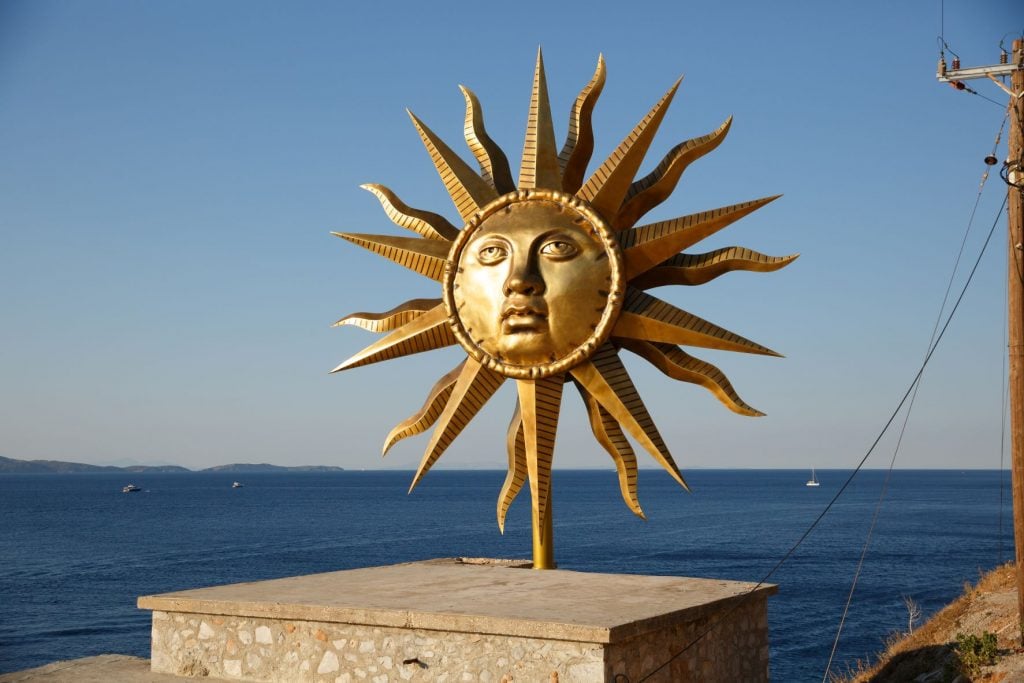
Jeff Koons, Apollo Windspinner, 2020–2022. Installation view of the exhibition “Jeff Koons: Apollo,” DESTE Foundation, Project Space, Slaughterhouse, Hydra © Jeff Koons, Photo: Eftychia Vlachou.
“I think of it as the island’s Statue of Liberty,” said Linda Yablonsky, the author of a forthcoming biography of Koons. “For those of us who know Dakis and know Jeff, that was a very touching and meaningful gesture.”
Meanwhile, just as this column was going to print, Koons’s artworks—small replicas of the moon—landed on the lunar surface, the first authorized artworks to reach that rocky terrain. Koons’s ability to pull off such a feat is what gives his fans confidence in their investments, despite market turbulence.
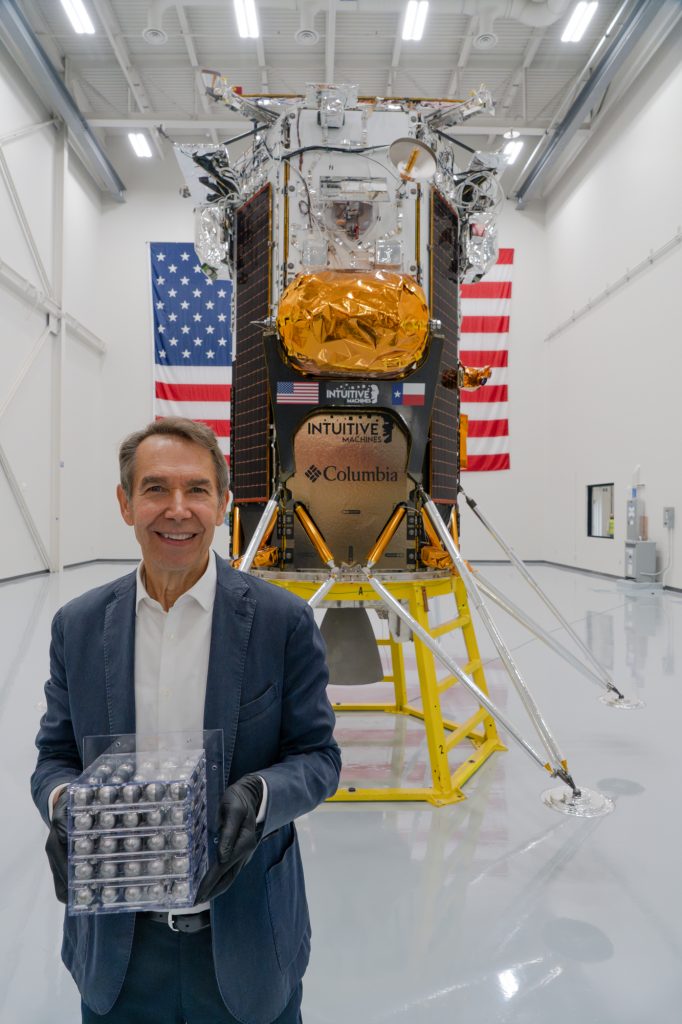
Jeff Koons holding Moon Phases, 2023. © Jeff Koons. Courtesy of Jeff Koons
“He’s moving every time in the area that you could not have even imagined,” Joannou said when we spoke. “You can never catch up with him. Now he’s off to the moon!”
Koons’s market is also ready for blastoff, his boosters argue.
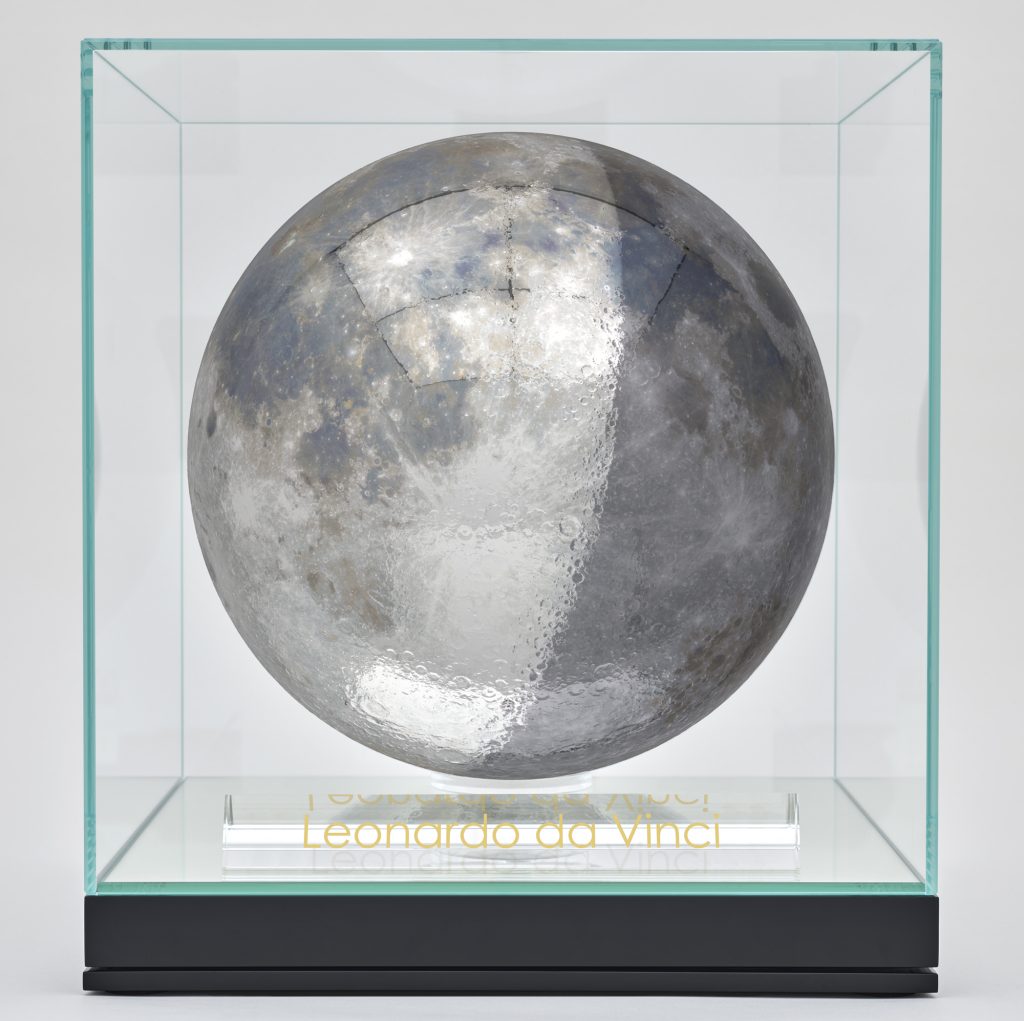
Rendering of Moon Phase (Leonardo da Vinci) by Jeff Koons © Jeff Koons. Courtesy of Jeff Koons
“This is the right time to buy Jeff Koons,” said Alberto Mugrabi, a collector and trader whose family bought the orange Balloon Dog for $58.4 million in 2013. “Jeff Koons has only one way to go, and that’s up.”





